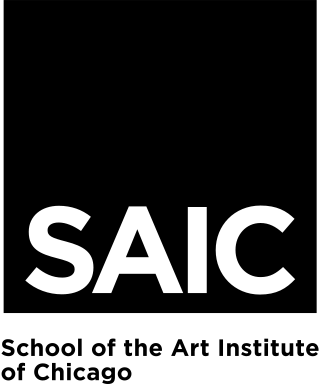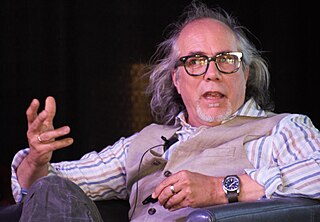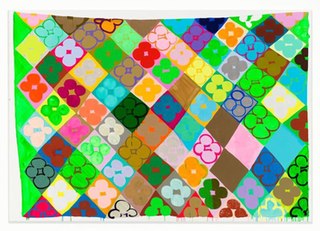Related Research Articles

The School of the Art Institute of Chicago (SAIC) is a private art school associated with the Art Institute of Chicago (AIC) in Chicago, Illinois. Tracing its history to an art students' cooperative founded in 1866, which grew into the museum and school, SAIC has been accredited since 1936 by the Higher Learning Commission, by the National Association of Schools of Art and Design since 1944, and by the Association of Independent Colleges of Art and Design (AICAD) since the associations founding in 1991. Additionally it is accredited by the National Architectural Accrediting Board. In a 2002 survey conducted by Columbia University's National Arts Journalism Program, SAIC was named the "most influential art school" in the United States.
Achy Obejas is a Cuban-American writer and translator focused on personal and national identity issues, living in Benicia, California. She frequently writes on her sexuality and nationality, and has received numerous awards for her creative work. Obejas' stories and poems have appeared in Prairie Schooner, Fifth Wednesday Journal, TriQuarterly, Another Chicago Magazine and many other publications. Some of her work was originally published in Esto no tiene nombre, a Latina lesbian magazine published and edited by tatiana de la tierra, which gave voice to the Latina lesbian community. Obejas worked as a journalist in Chicago for more than two decades. For several years, she was also a writer in residence at the University of Chicago, University of Hawaii, DePaul University, Wichita State University, and Mills College in Oakland, California. She also worked from 2019 to 2022 as a writer/editor for Netflix on the bilingual team in the Product Writing department.
Fausto Fernós is an openly gay Puerto Rican podcaster, performance artist, and drag performer. He originated and co-hosts the Feast of Fun, an award-winning daily comedy talk show, with his partner Marc Felion. They were the first openly gay couple to win a People's Choice Podcast Award, which they have won five times, and been nominated for the top prize of "People's Choice" six times in a row. Fernós currently resides in Chicago, Illinois.
The Feast of Fun podcast is a Chicago, Illinois-based talk show hosted by Fausto Fernós and Marc Felion that showcases celebrity guests, artists, musicians, actors, and members of the LGBT community and those who support them. A typical program will include one or more of a number of features, including roundtable discussions, unusual news and social trends, LGBT issues, comedy, music, food and cocktail recipes, or interviews.

Boeing Galleries are a pair of outdoor exhibition spaces within Millennium Park in the Loop community area of Chicago in Cook County, Illinois, United States. The spaces are located along the south and north mid-level terraces, above and east of Wrigley Square and the Crown Fountain. In a conference at the Chicago Cultural Center, Boeing President and Chief Executive Officer James Bell to Chicago Mayor Richard M. Daley announced Boeing would make a $5 million grant to fund both the construction of and an endowment for the space.

Chase Promenade is an open-air, tree-lined, pedestrian walkway that opened July 16, 2004. It is part of Millennium Park, which is located in the Loop community area of Chicago, Illinois in the United States. The promenade was made possible by a gift from the Bank One Foundation. It is 8 acres (3.2 ha) and used for exhibitions, festivals and other family events as well as private rentals.
Visual arts of Chicago refers to paintings, prints, illustrations, textile art, sculpture, ceramics and other visual artworks produced in Chicago or by people with a connection to Chicago. Since World War II, Chicago visual art has had a strong individualistic streak, little influenced by outside fashions. "One of the unique characteristics of Chicago," said Pennsylvania Academy of Fine Arts curator Bob Cozzolino, "is there's always been a very pronounced effort to not be derivative, to not follow the status quo." The Chicago art world has been described as having "a stubborn sense ... of tolerant pluralism." However, Chicago's art scene is "critically neglected." Critic Andrew Patner has said, "Chicago's commitment to figurative painting, dating back to the post-War period, has often put it at odds with New York critics and dealers." It is argued that Chicago art is rarely found in Chicago museums; some of the most remarkable Chicago artworks are found in other cities.
An alternative exhibition space is a space other than a traditional commercial venue used for the public exhibition of artwork. Often comprising a place converted from another use, such as a store front, warehouse, or factory loft, it is then made into a display or performance space for use by an individual or group of artists. According to art advisor Allan Schwartzman "alternative spaces were the center of American artistic life in the '70s."

Iñigo Manglano-Ovalle is an American conceptual artist known for multidisciplinary, socially oriented sculpture, video and installations and urban community-based projects of the 1990s. His work often explores a dialectical relationships involving minimalist aesthetics, the utopian ambitions of modernism and science, and the resulting—often negative—social, geopolitical and ecological consequences of such ideologies. New York Times critic Holland Cotter wrote that Manglano-Ovalle was adept in "distilling complex ideas into inviting visual metaphors," while Jody Zellen described his work as "infused with a formal elegance and sociopolitical content." Manglano-Ovalle has been featured in solo exhibitions at the Art Institute of Chicago, MASS MoCA, Museo Tamayo Arte Contemporaneo and Museum of Contemporary Art, Chicago (MCA), and participated in Documenta 12, the Venice Biennale, Whitney Biennial, and Bienal de São Paulo. He has been recognized with MacArthur Foundation, Guggenheim, and National Endowment for the Arts fellowships and his work belongs to the collections of forty major institutions. He has been a professor at Northwestern University since 2012 and lives and works in Chicago.

"Por Debajo de la Mesa" is a song written by Armando Manzanero and performed by Mexican recording artist Luis Miguel. Arranged by Bebu Silvetti, it was one of the two original compositions written for Miguel's fifteenth studio album Romances. It was released as the lead single from the album on 15 July 1997 and it became his thirteenth number-one single on the Billboard Hot Latin Songs chart in the United States. The music video features Miguel performing at a fine-dining restaurant in New York City.
The MCA Stage is the Museum of Contemporary Art, Chicago’s performing arts program. Founded in 1996 with the opening of the MCA’s new building in Chicago, Illinois.
Peter Taub was the director of performance programs at the Museum of Contemporary Art, Chicago and is now an independent freelance curator. Taub served as the head of the MCA’s performing arts program since its conception in 1996 until his departure in 2016.
Joan Dickinson is a contemporary American artist, writer, director, curator, and educator. Her creative practice combines visual and performance art, photography, writing, farming and environmental restoration, astrology, ceremony, and palliative care. Dickinson holds a doctorate (2012) from the Literary Arts program at the University of Denver.
Jackie Kazarian (Armenian: Ջեքի Ղազարյան), is an American painter, video artist, and installation artist of Armenian descent.
Julia Fish is an American artist whose paintings have a deceptive simplicity. She paints in oil on stretched rectangular canvases of varying size. By means of close observation of everyday subjects—leaves of a tree seen through a window, a section of floor tiles, an old fashioned light fixture— she makes, as one critic says, "quiet, abstract manifestations of observed realities." She is a studio artist who paints not what she sees in an instant but rather what she observes continuously, day after day. The result, she says, is not so much temporal as durational. Her paintings compress many instances of observation so as to become, as she sees it, "a parallel system to a lived experience." The paintings lack spatial orientation and, as a critic says, can "be described as both highly realistic and abstract without compromising either term." In 2008, Alan G. Artner, writing in the Chicago Tribune, said "This is work of small refinements and adjustments. The world of everyday things generates it, but Fish's qualities of seeing and touch elevate the things to a plane on which they leave behind their humble character."
Jan Cicero Gallery was a contemporary art gallery founded and directed by Jan Cicero, which operated from 1974 to 2003, with locations in Evanston and Chicago, Illinois and Telluride, Colorado. The gallery was noted for its early, exclusive focus on Chicago abstract artists at a time when they were largely neglected, its role in introducing Native American artists to mainstream art venues beyond the Southwest, and its showcasing of late-career and young women artists. The gallery focused on painting, and to a lesser degree, works on paper, often running counter to the city's prevailing art currents. It was also notable as a pioneer of two burgeoning Chicago gallery districts, the West Hubbard Street alternative corridor of the 1970s, and the River North district in the 1980s.
Leopold Segedin is an American artist and educator based in Chicago. He is best known as an urban figurative painter, who portrays humanist scenes of life in mid-20th century Chicago. He has exhibited for over 70 years, including retrospectives at the Chicago Cultural Center, University Club of Chicago, University of Illinois, and Northeastern Illinois University, and major group shows at the Art Institute of Chicago, Milwaukee Institute of Art & Design, Illinois State Museum and Des Moines Art Center, among others. His art has received awards from the Art Institute of Chicago, Terry Art Institute, Corcoran Gallery of Art, and American Jewish Arts Club. Segedin was one of Art in America’s 1956 "New Talent in the U.S.A." artists and has been featured in The Washington Post, Chicago Tribune, The Philadelphia Inquirer, Chicago Daily News and Chicago Sun-Times, among many publications. Chicago Tribune critic Alan Artner characterized Segedin's work as a "distinguished example" of magic realism; in visual terms, critics have often noted his vivid color, dynamic illusionist space, and rendering of light and surfaces that betray the passage of time.

Frank Piatek is an American artist, known for abstract, illusionistic paintings of tubular forms and three-dimensional works exploring spirituality, cultural memory and the creative process. Piatek emerged in the mid-1960s, among a group of Chicago artists exploring various types of organic abstraction that shared qualities with the Chicago Imagists; his work, however relies more on suggestion than expressionistic representation. In Art in Chicago 1945-1995, the Museum of Contemporary Art, Chicago (MCA) described Piatek as playing “a crucial role in the development and refinement of abstract painting in Chicago" with carefully rendered, biomorphic compositions that illustrate the dialectical relationship between Chicago's idiosyncratic abstract and figurative styles. Piatek's work has been exhibited at institutions including the Whitney Museum, Art Institute of Chicago, MCA Chicago, National Museum, Szczecin in Poland, and Terra Museum of American Art; it belongs to the public art collections of the Art Institute of Chicago and MCA Chicago, among others. Curator Lynne Warren describes Piatek as "the quintessential Chicago artist—a highly individualistic, introspective outsider" who has developed a "unique and deeply felt world view from an artistically isolated vantage point." Piatek lives and works in Chicago with his wife, painter and SAIC professor Judith Geichman, and has taught at the School of the Art Institute of Chicago since 1974.

Judy Ledgerwood is an American abstract painter and educator, who has been based in Chicago. Her work confronts fundamental, historical and contemporary issues in abstract painting within a largely high-modernist vocabulary that she often complicates and subverts. Ledgerwood stages traditionally feminine-coded elements—cosmetic and décor-related colors, references to ornamental and craft traditions—on a scale associated with so-called "heroic" abstraction; critics suggest her work enacts an upending or "domestication" of modernist male authority that opens the tradition to allusions to female sexuality, design, glamour and pop culture. Critic John Yau writes, "In Ledgerwood’s paintings the viewer encounters elements of humor, instances of surprise, celebrations of female sexuality, forms of vulgar tactility, and intense and unpredictable combinations of color. There is nothing formulaic about her approach."

Neil Goodman is an American sculptor and educator, known for bronze works that combine elegant arrangements and forms with hand-wrought, textured surfaces. He has explored a wide range of formats—still-life compositions, wall and floor installations, free-standing works and monumental public art—in a formalist style that has evolved from spare representation to abstraction and minimalism.
References
- ↑ Artner, Alan G. "To market...as an alternative" Chicago Tribune (17 Aug 1979: B12)
- ↑ Obejas, Achy "A Requiem for Chicago's Incubator of Performance Art" Chicago Tribune (23 Feb 1998: 1)
- ↑ Warren, L. 1984. Alternative Spaces: A History in Chicago. Chicago. Museum of Contemporary Art.
- ↑ Obejas, Achy "A Requiem for Chicago's Incubator of Performance Art" Chicago Tribune (23 Feb 1998: 1)
- ↑ Artner, Alan G. Muntadas' Installation Fits Current Thinking" Chicago Tribune (27 May 1994: 64)
- ↑ P-Form: performance art news https://digitalcollections.saic.edu/pform
- ↑ Hixson, Kathryn "Randolph Street Gallery" New Art Examiner (Sep 2000: 50-51) v28 n1
- ↑ Obejas, Achy "Randolph Street Gallery Closes, Victim of Rapidly Declining Funds" Chicago Tribune (14 Feb 1998: 5)
- ↑ Hixson, Kathryn "Randolph Street Gallery" New Art Examiner (Sep 2000: 50-51) v28 n1
- ↑ Randolph Street Gallery Archives https://www.saic.edu/academics/libraries-special-collections/john-flaxman-library/special-collections/randolph-street-gallery
- ↑ "Randolph Street Gallery Archives | SAIC Digital Collections". digitalcollections.saic.edu. Retrieved 2019-02-06.